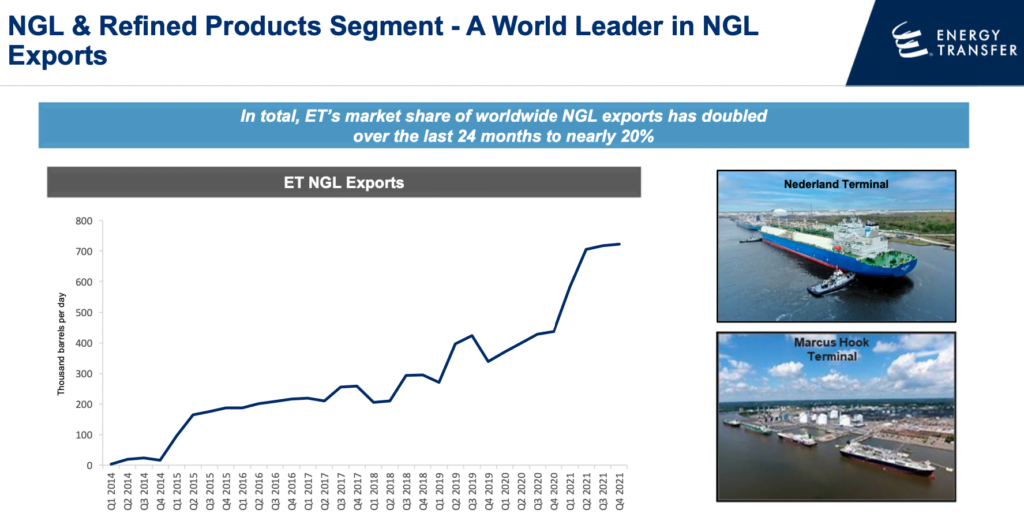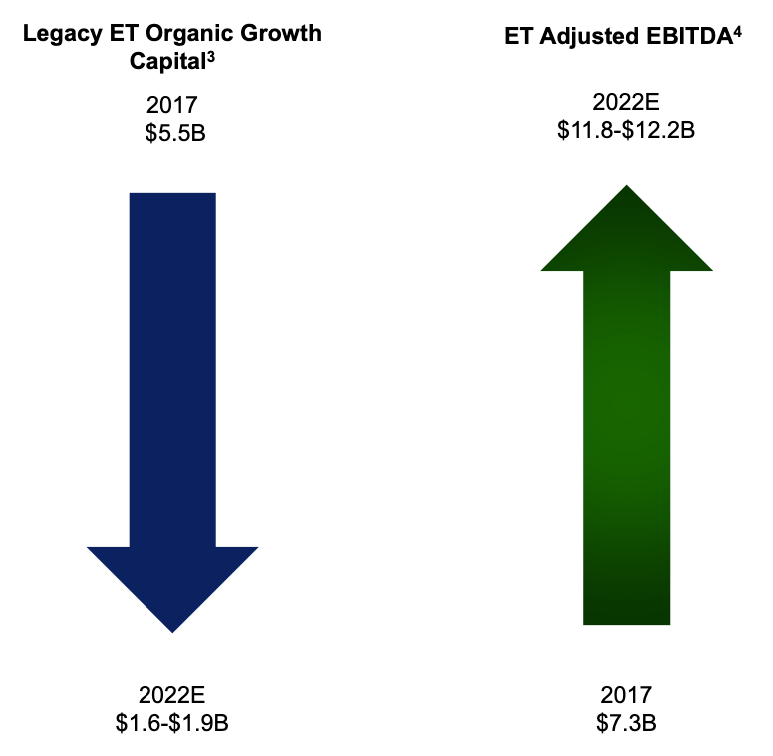Insider Weekends: Michael Grimm Purchases $5.66 Million Worth Of Energy Transfer
Natural gas prices were range bound for the better part of the last decade, oscillating between $2 and $4 per million British thermal units (MMBtu) with the occasional spike outside that tight range. With a constant increase in supply and lackluster demand, beyond some unusually cold winters, many energy production companies started to shift production away from natural gas to focus on crude oil while others looked at more lucrative markets in the East to ship the excess natural gas. To ship natural gas to other international market, the gas has to be liquified first to create LNG and then shipped via special ocean tankers.
When you think about the big jump in natural gas prices in Europe and the upcoming disruption to supplies from Russia, Cheniere Energy (LNG) comes to mind. The company spent several years investing in building LNG terminals and in February 2016 started to export LNG. I had looked at Cheniere several times over the years but the company’s net losses, large capital investments and massive debt load in an environment that wasn’t favorable for natural gas prices did not give me much confidence. All of that changed with the current geopolitical environment.
Another company that been building the infrastructure to export LNG and that struck a 20 year deal to supply LNG to China’s ENN last month is Energy Transfer LP (ET). As you can from the following chart from the company’s investor presentation, the company is starting to become a world leader in LNG exports.

ET happens to be one of the few energy companies with significant insider ownership and it is always encouraging to see an independent director purchase shares on the open market like Mr. Michael Grimm did through his family partnership and for his children’s accounts. Mr. Grimm has served on the company’s board since October 2018 and has over 43 years of experience in the oil and natural gas industry.
While ET’s stock has done well this year, up nearly 40%, it has significantly underperformed its peers over the last five years and had negative returns during that period. Like Cheniere, the company has been investing heavily into its infrastructure and has managed to grow through a string of acquisitions. This left the company with a very large debt load (an astounding $50.23 billion in net debt) and low net income margins compared to peers. Just like Cheniere, this has changed in recent quarters and the company plans to scale back capital investments and increase EBITDA in 2022 as you can see below.

Beyond Energy Transfer, it was fascinating to see that four out of the top five insider purchases last week were either directly or indirectly related to the housing market. Maybe these insiders don’t really buy into the idea that housing may have peaked and that mortgage rates are likely to continue rising in the near future.
Welcome to edition 614 of Insider Weekends. Insider buying more than doubled last week with insiders purchasing $113.3 million of stock compared to $54.4 million in the week prior. Selling on the other hand decreased slightly to $1.41 billion compared to $1.42 billion in the week prior.
Sell/Buy Ratio: The insider Sell/Buy ratio is calculated by dividing the total insider sales in a given week by total insider purchases that week. The adjusted ratio for last week dropped to 12.43. In other words, insiders sold more than 12 times as much stock as they purchased. The Sell/Buy ratio this week was unfavorable compared to the prior week when the ratio stood at 26.03.
If you found this article informative and would like to receive Insider Weekends by email every weekend, click here to subscribe for free.
Notable Insider Buys:
1. Energy Transfer LP (ET): $11.23
Director Michael K. Grimm acquired 504,600 shares of this energy-related services provider, paying $11.21 per share for a total amount of $5.66 million. These shares were purchased indirectly by a family limited partnership and Mr. Grimm’s children.
You can view the list of recent insider transactions for Energy Transfer LP here.
| P/E: 5.94 | Forward P/E: 7.64 | Industry P/E: 12.19 |
| P/S: 0.51 | Price/Book: 1.37 | EV/EBITDA: 7.85 |
| Market Cap: $34.62B | Avg. Daily Volume: 22,938,682 | 52 Week Range: $7.75 – $11.66 |
2. Alset EHome International Inc. (AEI): $0.7434
Chief Executive Officer Heng Fai Chan acquired 8,482,334 shares of this property development company, paying $0.65 per share for a total amount of $5.51 million. Mr. Chan increased his stake by 29.50% to 37,231,633 shares with this purchase.
You can view the list of recent insider transactions for Alset EHome International Inc. here.
| P/E: N/A | Forward P/E: N/A | Industry P/E: 39.25 |
| P/S: 3.67 | Price/Book: 0.24 | EV/EBITDA: 20.12 |
| Market Cap: $95.53M | Avg. Daily Volume: 8,374,574 | 52 Week Range: $0.25 – $12.1 |
3. Rocket Companies, Inc. (RKT): $9.7
Chief Executive Officer Jay Farner acquired 88,900 shares of this tech-driven real estate company, paying $10.32 per share for a total amount of $917,298. Mr. Farner increased his stake by 5.81% to 1,620,207 shares with this purchase.
You can view the list of recent insider transactions for Rocket Companies, Inc. here.
| P/E: 4.18 | Forward P/E: 7.46 | Industry P/E: 7.42 |
| P/S: 1.46 | Price/Book: 1.84 | EV/EBITDA: 4.26 |
| Market Cap: $19.28B | Avg. Daily Volume: 5,608,801 | 52 Week Range: $9.605 – $23.33 |
4. Thor Industries, Inc. (THO): $81.47
Director James L. Ziemer acquired 10,000 shares of this recreational vehicles company, paying $80.53 per share for a total amount of $805,295. Mr. Ziemer increased his stake by 50.42% to 29,835 shares with this purchase.
You can view the list of recent insider transactions for Thor Industries, Inc. here.
| P/E: 4.93 | Forward P/E: 6.24 | Industry P/E: N/A |
| P/S: 0.3 | Price/Book: 1.39 | EV/EBITDA: 4.19 |
| Market Cap: $4.48B | Avg. Daily Volume: 1,042,114 | 52 Week Range: $77.16 – $149.38 |
5. Green Brick Partners, Inc. (GRBK): $19.07
Director Harry Brandler acquired 25,000 shares of this homebuilding and land development company , paying $19.97 per share for a total amount of $499,250. Mr. Brandler increased his stake by 112.24% to 47,274 shares with this purchase.
You can view the list of recent insider transactions for Green Brick Partners, Inc. here.
| P/E: 5.13 | Forward P/E: 4.2 | Industry P/E: 9.78 |
| P/S: 0.69 | Price/Book: 1.17 | EV/EBITDA: 5.72 |
| Market Cap: $967.99M | Avg. Daily Volume: 523,398 | 52 Week Range: $18.97 – $32.25 |
You can view the full list of purchases from this Insider Buying page.
Notable Insider Sales:
1. GATX Corporation (GATX): $116.91
Chairman, President and CEO Brian A. Kenney sold 124,508 shares of this railcar leasing company for $121.10, generating $15.08 million from the sale.
You can view the list of recent insider transactions for GATX Corporation here.
| P/E: 29.37 | Forward P/E: 18.35 | Industry P/E: 14.58 |
| P/S: 3.29 | Price/Book: 2.05 | EV/EBITDA: 14.9 |
| Market Cap: $4.14B | Avg. Daily Volume: 190,736 | 52 Week Range: $84.5 – $127.58 |
2. Alphabet Inc. (GOOG): $2680.21
Shares of Alphabet were sold by 2 insiders:
- SVP, Chief Business Officer Philipp Schindler sold 3,907 shares for $2840.03, generating $11.09 million from the sale.
- Senior Vice President Prabhakar Raghavan sold 1,276 shares for $2816.49, generating $3.59 million from the sale.
You can view the list of recent insider transactions for Alphabet Inc. here.
| P/E: 23.89 | Forward P/E: 19.68 | Industry P/E: 23.29 |
| P/S: 6.86 | Price/Book: 7.05 | EV/EBITDA: 18.57 |
| Market Cap: $1.77T | Avg. Daily Volume: 1,556,019 | 52 Week Range: $2230.05 – $3042 |
3. Regeneron Pharmaceuticals, Inc. (REGN): $738.84
Shares of this biotech company were sold by 4 insiders:
- President & CEO Leonard S. Schleifer sold 10,000 shares for $710.04, generating $7.1 million from the sale. These shares were sold indirectly by a trust.
- EVP General Counsel and Secret Joseph J. Larosa sold 5,114 shares for $690.73, generating $3.53 million from the sale.
- EVP Commercial Marion McCourt sold 1,000 shares for $701.82, generating $701,820 from the sale. These shares were sold as a result of exercising options immediately prior to the sale,
- Director Arthur F. Ryan sold 100 shares for $692.81, generating $69,281 from the sale.
You can view the list of recent insider transactions for Regeneron Pharmaceuticals, Inc. here.
| P/E: 10.27 | Forward P/E: 16.14 | Industry P/E: 89.15 |
| P/S: 4.99 | Price/Book: 4.2 | EV/EBITDA: 8 |
| Market Cap: $80.19B | Avg. Daily Volume: 748,755 | 52 Week Range: $469.8 – $747.421 |
4. Upstart Holdings, Inc. (UPST): $91.17
Shares of this cloud- based artificial intelligence (AI) lending platform were sold by 2 insiders:
- Chief Executive Officer Dave Girouard sold 91,665 shares for $108.43, generating $9.94 million from the sale. 8,332 of these shares were sold indirectly by a trust.
- General Counsel and Secretary Alison Nicoll sold 7,500 shares for $96.75, generating $725,648 from the sale.
You can view the list of recent insider transactions for Upstart Holdings, Inc. here.
| P/E: 63.76 | Forward P/E: 25.9 | Industry P/E: 7.72 |
| P/S: 9.06 | Price/Book: 9.45 | EV/EBITDA: 51.93 |
| Market Cap: $7.72B | Avg. Daily Volume: 11,319,738 | 52 Week Range: $75.15 – $401.49 |
5. United States Steel Corporation (X): $35.95
Shares of this steel company were sold by 5 insiders:
- President & CEO David B. Burritt sold 129,244 shares for $37.43, generating $4.84 million from the sale. These shares were sold indirectly by a trust. 43,530 of these shares were sold as a result of exercising options immediately prior to the sale.
- SVP-Chief Strat & Sustain Officer Richard Fruehauf sold 61,585 shares for $37.71, generating $2.32 million from the sale. 5,547 of these shares were sold as a result of exercising options immediately prior to the sale.
- SVP, GC & CCO Duane D. Holloway sold 40,346 shares for $37.71, generating $1.52 million from the sale.
- SVP & CFO Christine S. Breves sold 22,387 shares for $36.90, generating $826,080 from the sale.
- VP, Controller & CAO Manpreet Grewal sold 1,359 shares for $37.71, generating $51,248 from the sale.
You can view the list of recent insider transactions for United States Steel Corporation here.
| P/E: 2.42 | Forward P/E: 9.44 | Industry P/E: 9.63 |
| P/S: 0.46 | Price/Book: 1.05 | EV/EBITDA: 2.06 |
| Market Cap: $9.37B | Avg. Daily Volume: 19,854,357 | 52 Week Range: $17.98 – $39.25 |
You can view the full list of sales from this Insider Sales page.
Disclaimer: I hold a long position in Rocket Companies (RKT). Please do your own due diligence before buying or selling any securities mentioned in this article. We do not warrant the completeness or accuracy of the content or data provided in this article.
